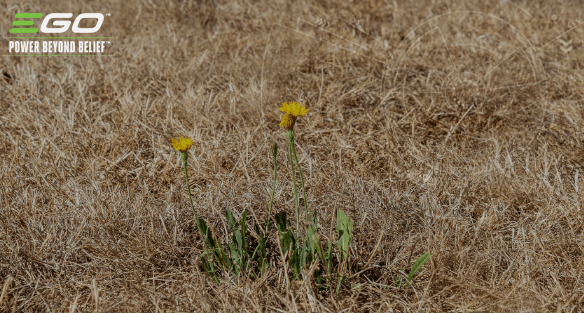Strong sunshine and high temperatures cause the soil beneath your lawn to heat up and dehydrate your turf above ground, leading to discolouration and, in extreme cases, patchiness.
The first thing to remember when faced by a heatwave that will put stress on your lawn is that grass is quite hardy and, given time, your lawn will most likely survive.
Here are some tips on what you can do to alleviate the heat stress on your lawn and help it to bounce back more quickly.
1. Use your battery lawn mower cautiously
We’ve talked a lot on our blog about ways to create more biodiversity in your garden by:
- Leaving your grass a bit longer.
- Leaving more time between mows.
- Not mowing the entire lawn, creating paths and areas instead.
These tactics also help to protect your lawn in hot summer conditions. Longer grass is more resilient, and shades the soil and controls its temperature, trapping and locking moisture in for longer too.
Longer grass will also offer shade to insects in extreme heat, which is important to tackle declining insect numbers.
Our cordless lawn mowers all have adjustable cutting heights:
- Our manual and self-propelled battery lawn mowers allow you to cut the grass to between 2cm and 9.5cm (20mm and 95mm), depending on model.
- Our Z6 Zero-Turn Ride-On (ZTR) mower has a large cutting height range of between 2.5 – 10cm (25mm and 100mm – 10 settings).
Discover more about why cutting height matters in our guide.
2. How and when to water your lawn
As well as leaving your lawn to grow longer, there are the obvious ways to keep it hydrated.
- As there are hosepipe bans in place in certain regions across Europe, check before you turn the tap on!
- You can use grey water on your garden in the short term. Grey water is tap water that has been used for something else, like boiling vegetables or bathing. It shouldn’t contain any harsh chemicals or human waste (this is black water) and is fit for your lawn. Discover more about using grey water on your garden in our guide.
- Don’t water your lawn in the hottest part of the day - the water will simply evaporate before your grass has had time to take a drink. Water early in the morning or when the sun is going down.
Before watering, please check your local water provider has not initiated a hosepipe ban.
3. Aerate your lawn
Aeration is by the process of creating space in your lawn’s soil to allow air, water and food to be absorbed. Earth becomes compacted over time, so aeration is good for soil health, which in turn, makes it good for your lawn.
If your lawn has already browned due to the effects of heat, aeration can help it recover more quickly. In normal conditions, you should aerate every 2 or 3 months in summer and a minimum of once a year otherwise.
- Using an aeration roller or garden fork, poke holes into your lawn at regular intervals.
- The depth of the holes should be about a hand’s breadth (2 to 6 inches or 5cm to 15cm).
- Don’t aerate if your soil is very dry - lightly water first or take advantage of an early morning dew or light shower.
4. Ongoing protection against heatwaves
Keep your soil as healthy as possible all year round , including aeration, feeding and including companion plants like clover and dandelions to enrich your lawn organically. If you want to add a shop bought lawn feed, choose an organic one (no chemicals) and go easy during very hot, dry weather.
5. Avoid artificial turf
Artificial turf retains and builds summer heat which can be a surprise, it has the potential to burn delicate skin on feet and paws. If you’ve got any in your garden or back yard, avoid contact when the sun is strong.
While it might look green all year round, this plastic product is very bad for the environment, your garden included. For example, most artificial turf has holes but still slows down water drainage, increasing flood risk when the rains return.
Also, the plastics used in artificial grass break down into microplastics, which are bad for human and animal health.
6. Look after yourself
You know the drill by now - wide-brimmed hats, loose and light clothing, sunscreen and plenty of water! While you’re keeping yourself hydrated, filling a bowl in a shady corner of your garden will help wildlife that might also be needing a drink.
Self-propelled cordless lawn mowers are ideal if you do have to cut your lawn, or a path through it, during a heatwave. They reduce the physical effort and will stop you over-heating.
7. Lastly - choose sustainable technology
Be kinder to the environment by choosing clean technology for your garden tools. Our range of cordless gardening tools - from lawn mowers to chain saws - are powered by the cleanest and most efficient battery technology available. Our tools outperform petrol equivalents yet they don’t give off toxic emissions. Find your nearest EGO dealer.
